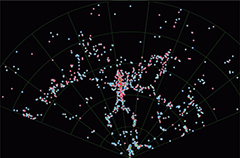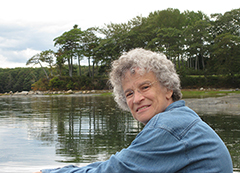19th Kaczmarczik Lecture
CLICK: THE 3D UNIVERSE"
Margaret J. Geller, PhD
Smithsonian Center for Astrophysics
Wednesday, October 22, 2014
2:00 p.m.
Main Building Auditorium
3141 Chestnut Street
Philadelphia, PA 19104
 We live in the first time when it is possible to map our universe. We now know that galaxies like our own Milky Way trace the largest patterns in nature. These patterns, first seen in a slice of the universe in 1986, extend for hundreds of millions of light years. Now, with large telescopes, we can trace the evolution of these patterns and compare them with some of the world’s largest computer simulations. A new survey, HectoMAP shows us the equivalent patterns in the universe nearly 7 billion years ago. A HectoMAP movie takes us through the data. Comparison of HectoMAP observations with simulations provides new direct tests of our understanding of the evolution of structure in the universe.
We live in the first time when it is possible to map our universe. We now know that galaxies like our own Milky Way trace the largest patterns in nature. These patterns, first seen in a slice of the universe in 1986, extend for hundreds of millions of light years. Now, with large telescopes, we can trace the evolution of these patterns and compare them with some of the world’s largest computer simulations. A new survey, HectoMAP shows us the equivalent patterns in the universe nearly 7 billion years ago. A HectoMAP movie takes us through the data. Comparison of HectoMAP observations with simulations provides new direct tests of our understanding of the evolution of structure in the universe.
 Margaret Geller received her BA (Physics) from UC Berkeley in 1970 and her PhD from the Princeton University Physics Department in 1975. She joined the permanent staff of the Smithsonian Astrophysical Observatory (part of the Harvard-Smithsonian Center for Astrophysics) in 1983.
Margaret Geller received her BA (Physics) from UC Berkeley in 1970 and her PhD from the Princeton University Physics Department in 1975. She joined the permanent staff of the Smithsonian Astrophysical Observatory (part of the Harvard-Smithsonian Center for Astrophysics) in 1983.
Geller is best known for her pioneering maps of the distribution of galaxies in the nearby universe. Together with COBE observations of fluctuations in the microwave background, these maps have profoundly changed our view of large-scale structure in the universe. Geller has also made substantial contributions to the study of galaxies and their environment. She has developed and applied techniques for measuring the matter distribution in clusters of galaxies. She is currently making a deeper map of the galaxy distribution called HectoMAP.
Geller is member of the National Academy of Sciences and of the American Academy of Arts and Sciences. She received a MacArthur Fellowship (1990), the Magellanic Premium (2008), the James Craig Watson Medal (2010), the Russell Lectureship (2010), the Lilienfeld Prize of the APS (2012), and the Schwarzschild Medal (2014) of the German Astronomical Society. She is a Library Lion of the New York Public Library (1997) and she has received 6 honorary degrees including one from Dartmouth College (2014).
Open House:
12:00-1:30 p.m. Physics Open House
Preceding the Lecture, the Department of Physics will hold an Open House consisting of exciting science demonstrations and exhibits with brief presentations on biophysics, astrophysics, computational physics, condensed matter physics, among others.
1:30-2:00 p.m. Refreshments.
About the Kaczmarczik Lecture
Paul Kaczmarczik began his career as a Professor of Physics at Drexel University in 1953. A key player in building the Physics and Atmospheric Science Department, he made important contributions to teaching at Drexel University during his many years of service. Well-liked by both his colleagues and his students, Professor Kaczmarczik became Professor Emeritus in 1989. The Kaczmarczik Lecture Series was established in 1995 in honor of Professor Kaczmarczik. It brings to Drexel outstanding scientists to present lectures on topics at the cutting edge of Physics research.